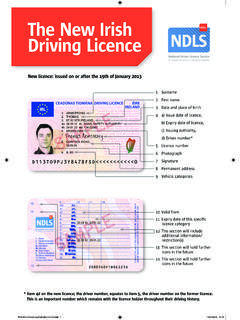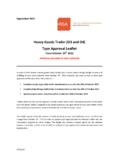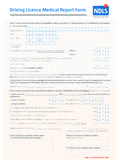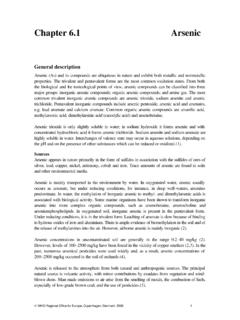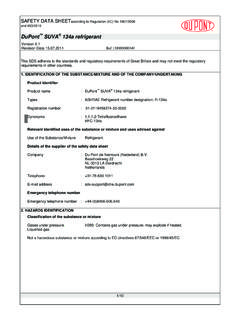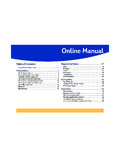Transcription of Information Note for Euro 5 and Euro 6 Emissions ...
1 The Introduction of euro 5 and euro 6 Emissions regulations for light passenger and commercial Vehicles Introduction As a member of the European Union, Ireland is obliged to introduce Regulation (EC) No. 715/2007 and it s implementing Regulation (EC) No. 692/2008. This Regulation will set tighter emission limits, known as euro 5 and euro 6, of atmospheric pollutants such as particulates and nitrogen oxide for vehicles sold in the EU market. euro 5 will apply to passenger cars and light duty vehicles of categories M1, M2, N1 and N2 (all with a reference mass not exceeding 2,610kg) and will be mandatory for vehicles registered from the 1st January 2011 or from 1st January 2012 for some vehicles, see later for details.
2 euro 6 will apply to new vehicle registrations from 2015, and in particular will set tougher emission limits for nitrogen oxides. Implementation dates for each vehicle category are summarised further in this document. This Regulation controls the Emissions of vehicles with a reference mass up to 2,610kg and removes them from the scope of directive 2005/55/EC. Reference mass means the mass of the vehicle in running order less the uniform mass of the driver of 75kg and increased by a uniform mass of 100kg (refer to Certificate of Conformity point ).
3 Objectives of the Regulation Reducing Emissions from road transport is seen as an important factor in the improvement of air quality, particularly because the share of diesel vehicles in the overall sales of light duty vehicles is increasing. The euro 5 and 6 Regulation revises the current emission limits for motor vehicles (the euro 4 standards, which have applied since 1st January 2005), as technology has improved. The specific objectives cover: Setting harmonised rules on the construction of motor vehicles, and Improving air quality by reducing pollutants emitted from the road transport sector by setting the next stage of emission limit values for passenger cars and light -duty vehicles in a cost-effective way.
4 Background Although air quality has improved over the past decade, there are still significant problems throughout the European Union, especially in urban areas and in densely populated regions. Member States and their citizens are concerned about the risks to human health and the environment that results from such air pollution. In that context, euro 5 and euro 6 standards lay down common EU rules on the construction of motor vehicles with regard to the emission of atmospheric pollutants (both particulates and nitrogen oxides) from light duty vehicles.
5 The technical requirements take effect in two stages, euro 5 emission limits will come into effect for new type approvals from 1st September 2009 (and new registrations from 1st January 2011) and euro 6 emission limits will apply for new type approvals from 1st September 2014 (and new registrations from 1st September 2015). The main effect of euro 5 is to reduce the emission of particulate matter from diesel cars from 25mg/km to 5mg/km. This will make the introduction of particle filters for diesel cars obligatory.
6 euro 6 limits will mainly reduce the Emissions of nitrogen oxide from diesel cars further, from 180mg/km to 80mg/km. This Regulation also sets out requirements for unrestricted access to vehicle repair Information , and in particular to that Information relating to on-board diagnostic (OBD) systems and their interaction with other vehicle systems. OBD systems play an important role in the control of vehicle Emissions . Implications for Irish Stakeholders Although there is no indigenous engine manufacturing industry in Ireland, the introduction of the euro 5 and euro 6 Regulation will have type approval implications for a number of sectors such as importers, distributors and converters of light passenger and commercial vehicles, as well as the Irish consumer.
7 It is essential that vehicle importers, distributors and convertors are aware of the effective dates of implementation for euro 5 and euro 6 and their applicability. The improvements to air quality that will result from the introduction of the Regulation will likely lead to improved public health and thus enable the Irish Government to generate savings. It will also guarantee a common level of Emissions amongst all vehicles in the EU. Whilst the introduction of new technologies will likely bring additional costs to consumers, the new emission limit values of euro 5 and euro 6 have been calculated to ensure a balance is achieved between higher environmental standards and continued affordability of cars and light duty vehicles both in the diesel and the petrol markets.
8 Requirements of the Regulation Given the need for uniform standards, the Commission has devised procedures, tests and specific requirements for the following: Tailpipe Emissions , including test cycles, low ambient temperature Emissions , Emissions at idling speed, exhaust gas opacity, and the proper functioning and regeneration of after- treatment systems; Evaporative Emissions and crankcase Emissions ; On-board diagnostic systems and the performance of anti-pollution devices while the vehicle is running; Durability of anti-pollution devices, replacement parts for Emissions control systems, in-service conformity, conformity of production and technical control; Carbon dioxide Emissions and fuel consumption; Hybrid vehicles; Extension of approvals and requirements for small manufacturers.
9 Requirements for testing equipment, and Reference fuels, such as petrol, diesel fuel, gas and biofuels. Easy and clear access to Information on vehicle repair and maintenance is essential in guaranteeing free competition on the internal market for Information and repair services. To this end, manufacturers must ensure that independent operators have easy, restriction-free and standardised access via the internet to Information on the repair and upkeep of vehicles, without discrimination in favour of dealerships and official repair workshops.
10 This obligation covers on-board diagnostic systems and their components, diagnostic tools and testing equipment. Charges for accessing such Information are permitted if they are reasonable and proportionate. Under Regulation (EC) 715/2007, the sale or installation on a vehicle of replacement pollution control devices that are not type approved is prohibited. Type Approval and Registration Dates The implementation dates of euro 5/6 for new type approvals and new registrations for various vehicle types (with a reference mass not exceeding 2,610kg) are summarised in the table below.





